Erika Harriford-McLaren
BUSINESS ASIA
The second day of any conference is always hard. To rejuvenate the delegates after the TNS boat cruise the night before, the boost session from the morning featured a Changing Faces performance. Although a hard act to follow, David Smith, of DVL Smith and Maryan Broadbent of AIA Insurance Group somehow managed to do it and do it well. They discussed how AIA insurance came to better understand the customer while also understanding themselves – by embedding the customer into their company and creating a dedicated insight role in their organisation.
The key to achieving this is having a helicopter view – being the organisation’s wide-angle lens. This involves mastering data synthesis and being a true insight creator by having strategic conversations and getting into the emotional mind of the customer. Be sure to tap into senior management emotions as well, because as Broadbent noted, you may have the best idea in the world, but if no one is listening then it doesn’t matter.
In the end, the key role of an insight professional is to make and create better decisions. Be prepared to take a point of view –admissible evidence if you like. Remember we are a global village – not all like – even within the same borders. Don’t be so obsessed with technique and methodology when communicating – learn to tell a story. And lastly, remember to balance having holistic-oriented team members with specialists to be able to truly understand and provide a well-rounded solution for your organisation and customers.
Session Chair, Darryl Andrew, welcomed the next speaker, Keith Spencer of Ipsos ASI, with a humorous story about him being confused with Sean Connery by a stewardess – a story which will forever have colleagues asking “shaken or stirred?”
Although lately mobile seems to be king at these type of events, Spencer bravely took on the topic of television advertising and gave us some pretty interesting tips on how to maximize our ROI from this platform. According to Spencer, despite obvious cultural differences, there are some basic global TV advertising principles that apply everywhere.
First and foremost, creative is king because in the end it’s about talking to your customers in a relative, relevant and interesting way. Spencer’s research showed that even with ads that had the same spend, creative elements were a key driver to an ad’s success.
He also found that ad recall builds in line with reach and not frequency. So your focus shouldn’t be as much on repetition, because response to TV advertising builds with diminishing returns. After a certain level of investment, you simply just don’t get much back by recall.
In the end, it’s basically not how much you spend but how creative you are with your ad. Strong creative may save you much in money and lift your brands recognition and value to consumers. Ensure the basics are in place rather than fragmenting existing media budgets with the addition of more multi-media touchpoints and don’t underspend on creative – it will lessen your chance for success!
Lastly, be sure to minimise the down versus maximising the up, i.e. it’s not efficient to spend a lot and then go off air for months. By reorganising your spend to build reach and retaining your recall curves, you will get people to have deeper impressions from your ad and your brand.
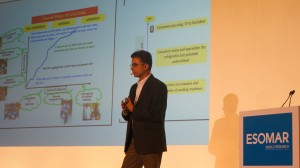 Following Spencer, came Sandeep Dutta, of TNS India, who it turns out was also associated with acting, and is still to this day being referred to by his character’s name (Steven) from a small part years ago. A client even thought that was his name!
Following Spencer, came Sandeep Dutta, of TNS India, who it turns out was also associated with acting, and is still to this day being referred to by his character’s name (Steven) from a small part years ago. A client even thought that was his name!
Dutta’s presentation delved into how to connect with rural India, and provided a really inspirational way to approach a market known to have untapped potential and a growing consumer culture – all done with respect for the differences in lifestyle and for respondent cooperation. Often the assumption is rural India = sachet marketing. However, with the rise of the rural rich – those with income based on things other than agriculture – there is a new category of people with money who wish to flaunt their new status.
Interestingly, the agency experienced the same challenges that client had (i.e. how to enter this market, how to get access to talk to the women). They also had the additional challenge of the client wanting a “jugad” i.e a quick fix including a medley of research tools (be sure to download the paper for a great explanation of this).
By recruiting cultural guides from locals they got acceptance and appreciation because people were aware and understood what they were doing and were not kept on the outside. From this they created a very collaborative process between agency and participants – echoing a theme from the conference day 1.
The LG marketing director of India, who could not attend, sent a video where he gave a resounding endorsement of the approach adopted and of the respect shown to respondents. As Darryl Andrew emphasized – couldn’t we all learn from showing that kind of respect?
LEARNING SKILLS
 So what does improv have to do with being a researcher? Lee Ryan, of Raspberry Innovation, gave what was undoubtedly one of the most interesting presentation/masterclasses on just why we should use improv to learn the value of “yes and” and become more spontaneous and creative.
So what does improv have to do with being a researcher? Lee Ryan, of Raspberry Innovation, gave what was undoubtedly one of the most interesting presentation/masterclasses on just why we should use improv to learn the value of “yes and” and become more spontaneous and creative.
Learning to be more physical and not just relying on the verbal is key for dealing with clients, and others, to get your point across better. Ryan believes researchers should be practicing their creative skills more and aiming for more creative collaboration. To prove this she engaged the audience in several fun, but thought provoking, exercises where they paired off and practiced several improv methods.
The use of these principles can be key in helping clients be changed by what they hear versus just listening to what you say. They show researchers how to move from verbal to non-verbal, to be accepting of risking mistakes and to get comfortable with the idea of being creative.
Global top 20 business schools are employing these sorts of creative collaboration courses, so why not be prepared to meet your future clients on the same level and speak their language? Time to flex your creative muscles….
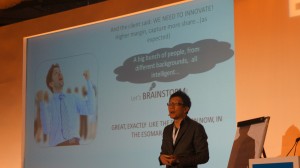 Jacky Cheung, from WIMI (When Insight meets Innovation) underscored this idea of collectiveness and creativity with his presentation on using a unique approach to grass roots creativity. Using an innovative approach to brainstorming by combining respondents, experts and a client, new and surprisingly unique solutions were developed to make the use of salt more interesting for housewives.
Jacky Cheung, from WIMI (When Insight meets Innovation) underscored this idea of collectiveness and creativity with his presentation on using a unique approach to grass roots creativity. Using an innovative approach to brainstorming by combining respondents, experts and a client, new and surprisingly unique solutions were developed to make the use of salt more interesting for housewives.
What they found was that by looking outside of professionals for R&D and involving the people, they could generate new product features that directly reflected what the consumer wanted. By adding creative and client-side professionals – they were able to draw out ideas that could in the end be realistically implemented.
If trying this be sure to provide directions or the professionals will dominate the conversation over the respondents, warned Cheung. That withstanding, it may well be worth a try, as WIMI found that by doing this they generated 23 new ideas from 12 people, making 7 new categories and 15 subcategories that included things like pre-measured salt capsules, spray bottle salt and salt biscuits. Innovation and brainstorming at its best.
 The final session of the morning was one that was well anticipated. The Key Client’s interview. Echoing many of the themes presented in the conference, the clients took time to give their perspectives on our industry and what it is they see occurring and felt is needed for future collaboration.
The final session of the morning was one that was well anticipated. The Key Client’s interview. Echoing many of the themes presented in the conference, the clients took time to give their perspectives on our industry and what it is they see occurring and felt is needed for future collaboration.
Wellington Chu, of Volvo Car, implored researchers to have the courage to challenge the client – to go beyond the brief. He suggested that one should be sure to get in with the big guys – to ask to see the CEO – because in the end it will likely be his perspective and not the researchers who will determine how your data may or may not be used. He also underscored knowing the business – i.e. understanding it and being able to “talk the talk” of that industry, which he believes will truly help to make researchers business partners because when you “get the client” then you can better drive their business.
Cindy Mao, of VF Corporation Asia, gave a good run down of the need for using impactful approaches to make research a real business driver. Be sure to articulate your research insights in an engaging way and to act as a partner by translating your data into strategy that can give true ROI. Try and develop research tools to helps clients address gaps in their business – i.e. gauge effectiveness and be sure to integrate your learnings with effective and complimentary online and offline strategies for brands. Finally, don’t be afraid to be creative and to facilitate discussion.
Lastly, Fang Jun of Unilever reminded researchers to remember that the world is not flat. There is no global consumer, so be sure to avoid ethnocentrism in research methodologies and gain a real consumer understanding of the region you are working with. Remember, Western styles of marketing may not always work best – so don’t just plan to duplicate Western ways.
THE TECHNO WAVE
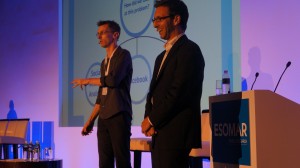 Lars Groeger of Macquarie Graduate School of Management and Scott Taylor of Soup, managed the amazing feat of keeping a post-lunch conference crowd both awake and interested, with their presentation on using social network analysis and Facebook to better understand word of mouth.
Lars Groeger of Macquarie Graduate School of Management and Scott Taylor of Soup, managed the amazing feat of keeping a post-lunch conference crowd both awake and interested, with their presentation on using social network analysis and Facebook to better understand word of mouth.
By developing a Facebook questionnaire app (not a pop quiz mind you), they were able to see how people connect by importing list and sharing surveys. This required great trust on the part of the participant, because as many of us know, letting someone access your Facebook information is akin to letting them into your home. If your community doesn’t trust you – then this type of research is wrong for your business. Consent is key.
They received 354 completes from their app, finding an average of 220 friends (the global Facebook avg. is 108) and 67 common friends. The reach from this underscores the potential impact of multiple exposure on purchase behavior. By using Facebook to link people’s connections in an offline environment – we may well be on our way to increasing the accuracy of WOM measurement across the industry as well as increasing the understanding of the reach of social networks.
Some caveats from Groeger and Taylor include awareness that facebook is not technically designed to do this, so be technically capable. Also know that Facebook is fluid, with programmers changing it daily so don’t expect to be able to perform the same functions the next day.
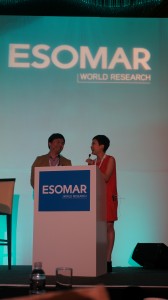 The Chinese online market is huge as we all know. But how do they use it when shopping, was a question addressed by David Shi of Nongren.com and Sharong Chow of Chictalk, when they set out to use social media to introduce the first designer-to-business-to-consumer website.
The Chinese online market is huge as we all know. But how do they use it when shopping, was a question addressed by David Shi of Nongren.com and Sharong Chow of Chictalk, when they set out to use social media to introduce the first designer-to-business-to-consumer website.
Using key words and text analytics, they set out to find out the Chinese consumers thoughts when purchasing designer clothes on line. What they found from delving into the minds of consumers was that they needed to be convinced that catwalk clothing was acceptable for daily wear and that designers needed to underscore that their materials were quality due to a fear of receiving cheap materials since one cannot feel texture online or might be buying an unknown brand.
Text analytics allowed them to follow the shopper journey and break the barriers to spending. This is good to remember, because although things may be cheaper in Asia than in the West, consumers still care about quality and value and when spending online this is even more important.
Alastair Gordon of Gordon & McCallum and Eric Gu of SSI also explored this idea of delving into the consumer mindset – but with a different view. Using facial imaging, they were able to measure consumer responses to marketing through the examination of facial expressions.
There are 6 universal emotions that cross cultures. So things like happiness, surprise, anger or fear are almost impossible to not detect. However, Gordon and Gu noted that things like culture matters in how these emotions are expressed. For example, Asians use more facial movement around their eyes when expressing emotions and Europeans around their mouths.
Through the use of unique nVisio software, they were able to map 143 points of facial muscles, which they could in turn measure for response to advertisements. They found that there was less than one-half second from seeing an image and the face responding. By viewing a face they could measure a response and determine what part of an advertisement is appealing to consumers and where potential drop off could occur.
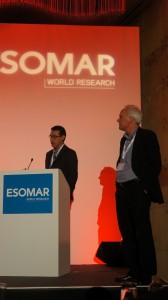 With minimal effort – respondent’s need only turn on a webcam, sit and watch an ad – this provides a simple, yet fascinating way to measure emotion and manage the creative process for advertisements and marketing.
With minimal effort – respondent’s need only turn on a webcam, sit and watch an ad – this provides a simple, yet fascinating way to measure emotion and manage the creative process for advertisements and marketing.
Next up were BrainJuicer’s Anna afHallstrom and Richard Shaw, who explored two big problems – scale and quality- when doing qualitative research in China.
Noting that a focus on Tier 1 cities leads to generalisations and stereotypes, BrainJuicer did a literature review on Chinese youth hypothesising that youth groups were either west-leaning or east leaning, and set out to see if this was true. An East vs. West experiment.
Using Digividuals – a research robot that searches the net and creates a personification to use to interact and engage target group for additional insights – they focused on Chinese websites using key words and associated key words. This content was posted on the blog as a personality – name, age and location i.e. a personal blog of the digividual. They then reviewed and analysed it and looked for key themes.
Using left and right leaning digividuals in 9 cities they retuned an astounding 32,000 + pieces of social media content. What they found was that although there were some locational differences, youth takes cues from both sides bridging left and right into their lives as needed. BrainJuicer also noted for you researchers out there curious about censorship and online research in China, that they did not experience centralised control over the media from government and thus having no impact on their analysis. They also underscored that you will need a local analyst to understand the content to give you a wider social range of understanding.
The final presentation of the day before the closing keynote addressed two important questions regarding gamification. Do survey gaming techniques cross cultures into Asia and can they reduce cultural response bias? This was the question that Jon Puleston and GMI set out to answer.
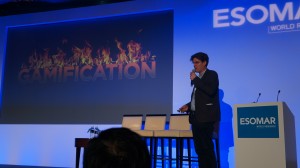 Testing 18 different techniques in 7 different countries, they found, that gaming techniques do indeed cross cultures, that the respondents invested more time answering questions, found it more fun and GMI received an improved quality of the data. Win-win-win –win….The use of simple things such as sliders with animations added made the surveys more fun and encouraged respondents to think about their answers more carefully before selecting them. The use of gambling style surveys such as predictive markets were very successful as well.
Testing 18 different techniques in 7 different countries, they found, that gaming techniques do indeed cross cultures, that the respondents invested more time answering questions, found it more fun and GMI received an improved quality of the data. Win-win-win –win….The use of simple things such as sliders with animations added made the surveys more fun and encouraged respondents to think about their answers more carefully before selecting them. The use of gambling style surveys such as predictive markets were very successful as well.
However, when looking at gamification for reducing cross-cultural response style bias, it only helped a bit… When thinking of doing this in Asia, remember language issues can pose a real problem and there can be varying levels of truthfulness due to culture – mostly driven mainly by economic incentive.
In the end, it’s good to remember that playfulness is pretty much a universal human instinct – so don’t be afraid to experiment with gamification in APAC.
There is an assumption that West is best, but according to Chris Jaques, CEO of M&C Saatchi Asia and closing keynote speaker, the future will be created by Asian companies and consumers and these times represent the dying days of corporate colonisation in Asia.
Jaques, who has lived in Asia for many years, gets frustrated when people call China and India developing nations, because as he proceeded to illustrate throughout his presentation, that moniker could not be more wrong, as history has shown.
When examining the world economies from the birth of Christ to today it is obvious which two countries have had the most developed economies for centuries upon centuries. It was not until the last two hundred years in fact that the West, due to industrialisation, became world leaders. This however, is all about to change believes Jacques, as things such as population, economy, spending and culture will all be increasing or driven from Asian power or influence.
There are 8 main factors that he believes will separate East from West. Asian organisations do not just rely on data but on gut feeling – instinctive insight – and this has proved highly successful over time. A great example was regarding Haier who made a washing machine for rural India that kept being returned broken. The company soon realized that the farmers were washing their vegetables in the machine. Instead of discontinuing the machines for the region, the company re-designed the machines to wash both clothes and vegetables.
Other factors that will change the rules o f the game include the use of pull versus push marketing, meaning they only develop services that customers say they want versus the other way around, where products are developed first and then pushed out to market.
As the West remains obsessed with architectural innovation, Asians are more likely to follow progression innovation – building piece by piece on a model and launching. If it fails it fails, but often success is found to balance this.
Asian companies are renowned for copying products, but the difference from sheer duplication is that they add something to make their version distinctive and then launch. Making the best better, following yet leading. This is often underscored through life-testing, meaning Asian companies often just try it. For example, where Apple may launch one phone in a year, Samsung will launch 10”s of them to see what works best in a market. Other factors include entrepreneurial agility, frugal innovation and liquid management, i.e. avoiding fixed costs.
Having seen several ESOMAR sessions, Jaques expressed his surprise at how interesting and advanced market research has become with ethnography, facial imaging and gamification. He said he saw he future where his industry would not only saw the potential for future relationships between the two areas, but the necessity as market research tools and knowledge were something that he was realising would be key to success for advertising and marketing in the future.



2 comments
I agree with your top ten maybe not in the same order but there all there…keep up the good work
[…] take you through each presentation and session, which has been done rather extensively here and here), I thought I’d give you the key themes I saw coming […]